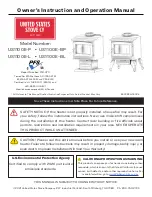
3
If the stove is to be fitted with a top flue, fit the collar on the top of the stove and the
blanking plate on the rear. Or the other way round if the flue is to be fitted from the rear of
the stove (see figure 1). A flat-bladed screw driver and 8mm spanner will be required.
The Rosedale SC requires a Class 1 chimney of it’s own, a shared chimney will not be
suitable. The chimney must be sound, free from leaks and swept before installation. If
the chimney requires lining, a lining must be used which is suitable for wood and solid fuel,
with a minimum of 150mm internal diameter. A metre of flue pipe should be used from
the stove before the chimney lining, and the lining must be installed to manufacturers
instructions. Alternatively, if there is no chimney, then an insulated stainless steel flue
may be used, to BS EN 15287 – 1: 2007 + A1:2010 with a minimum of 150mm internal
diameter, and must be installed to manufacturers instructions and to relevant Building
Regulations. The length of the chimney or flue must be at least 4.5 metres from the top of
the stove, and must finish in a down draught free area. A stove must not be installed into a
room where there is an extractor fan, or fumes could be pulled down the chimney.
It is essential to provide a facility for sweeping the chimney, and this may be done by
installing a soot door in the brickwork, or providing an access plate in the register plate or
flue pipe. When the flue is fitted from the top of the stove, the baffle can be removed to
sweep up through the stove.
To connect the flue pipe to an existing chimney, a register plate is required, preferably
made of metal. A collar is welded to the underside of the register plate so that the flue pipe
can be placed into the spigot on top/rear of the stove and round the outside of the collar on
the register plate, so forming a ‘funnel’ effect. In this way, any moisture running down the
chimney will be directed back into the stove instead of seeping out onto the top of the stove.
Connect the stove to the chimney using vitreous enamelled flue pipe, either from the top of
the stove, or from the rear. Horizontal flue must be kept to a minimum, no more that
150mm is allowed. Make sure that all joints and connections are well sealed.
When installation is complete, allow a suitable time for fire cement and mortar to dry, light
a fire and make sure all joints are sealed. The stove is painted with a high temperature paint
finish. The paint will be cured when most surfaces have reached about 246 degrees C.
During this burn off period you will notice an unpleasant smell; you should not touch or
wipe the paint during this period as it will be soft and may mark. The room should be well
ventilated, children and pets should be kept away. Do not use water to clean the stove,
either before or after it is cured.
LIGHTING THE STOVE
When ready to light the stove for the first time, make sure that everything is removed from
the ash pan. Place firelighters or paper and approximately 1.5 kg of dry kindling onto the
stove grate. Fully open both the primary and secondary air controls. Once lit, leave the
door slightly open for a period of 4 to 5 minutes or, until the fire has become well
established. At this stage slightly larger logs can be added and the firebox door closed.






























